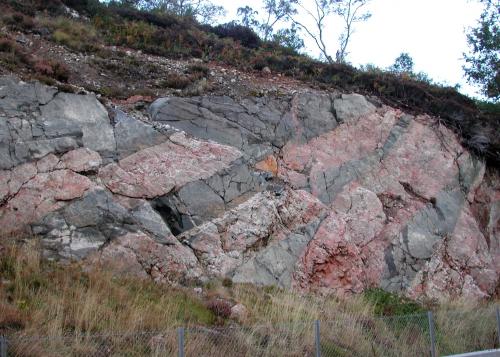
Granite dykes, showing baked margins and host rock assimilation. http://www.geologyrocks.co.uk/
What is Petrology?
Petrology (from the Greek πέτρα, petra, “rock” and λόγος, logos, “study”) is the branch of geology that studies the origin, composition, distribution and structure of rocks. Lithology was once approximately synonymous with petrography; but in current usage, lithology focuses on macroscopic hand-sample or outcrop-scale description of rocks, while petrography is the speciality that deals with microscopic details. In the oil industry, lithology, or more specifically mud logging, is the graphic representation of geological formations being drilled through, and drawn on a log called a mud log. As the cuttings are circulated out of the borehole they are sampled, examined (typically under a 10x microscope) and tested chemically when needed.
Methodology
Petrology utilizes the classical fields of mineralogy, petrography, optical mineralogy, and chemical analyses to describe the composition and texture of rocks. Modern petrologists also include the principles of geochemistry and geophysics through the studies of geochemical trends and cycles and the use of thermodynamic data and experiments to better understand the origins of rocks.
Branches
There are three branches of petrology, corresponding to the three types of rocks: igneous, metamorphic, and sedimentary, and another dealing with experimental techniques:
- Igneous petrology focuses on the composition and texture of igneous rocks (rocks such as granite or basalt which have crystallized from molten rock or magma). Igneous rocks include volcanic and plutonic rocks.
- Sedimentary petrology focuses on the composition and texture of sedimentary rocks (rocks such as sandstone, shale, or limestone which consist of pieces or particles derived from other rocks or biological or chemical deposits, and are usually bound together in a matrix of finer material).
- Metamorphic petrology focuses on the composition and texture of metamorphic rocks (rocks such as slate, marble, gneiss, or schist which started out as sedimentary or igneous rocks but which have undergone chemical, mineralogical or textural changes due to extremes of pressure, temperature or both)
- Experimental petrology employs high-pressure, high-temperature apparatus to investigate the geochemistry and phase relations of natural or synthetic materials at elevated pressures and temperatures. Experiments are particularly useful for investigating rocks of the lower crust and upper mantle that rarely survive the journey to the surface in pristine condition. The work of experimental petrologists has laid a foundation on which modern understanding of igneous and metamorphic processes has been built.